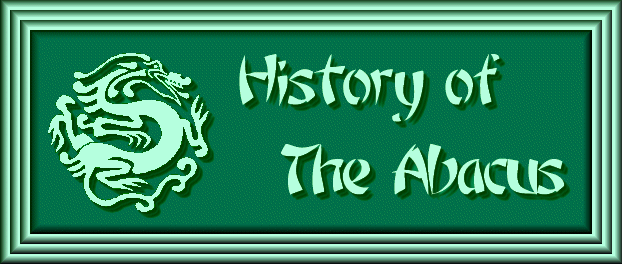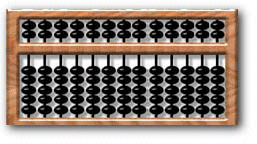




 |
|
The abacus was a great invention in ancient China and has been called by some Western writers "the earliest calculating machine in the world."

The abacus has a long history behind it. Its popularization occurred at the latest during the Song Dynasty (960-1127).
In the ancient civilizations of Egypt, Rome, and China, pencil and paper were luxuries and the numbering system was clumsy. Therefore, calculations were carried out using counting stones and rods. In fact, the Latin word for pebble, calculus, is the origin of the modern term calculate.
In its earliest form, the abacus was a board which was incised with a series of parallel grooves. Calculations were carried out by sliding pebbles back and forth in the grooves. In a later development, beads were strung on wires or thin strips of bamboo, reducing "crashes" and making the operation of the abacus less clumsy.
The most familiar form of the abacus was developed in China during the sixth century. The counters of this abacus (the suan pan) are divided into two sets, one set representing fives and the other set representing ones. This arrangement simplifies carrying while adding and borrowing while subtracting.
The beads on an abacus may be round or rhombus in shape. Traditionally, there are two beads above the horizontal bar and five below. Simplified modern versions have one bead above and four or five below. The methods of calculation remain unchanged.
Abacuses are easy to make, handy to carry around and quick to give the answers, provided one knows how to move the beads. They have been in use, therefore, down to this day. They are made in different sizes, and the largest known abacus, measuring 26 centimeters high by 306 centimeters long with 117 rods (for as many digits), is over a hundred years old and is kept at Darentang, a well-known traditional pharmacy in Tianjin.
With the introduction of Arabic numerals, the popularity of the abacus began to decline. The modern computer has only served to hasten its demise. However, the abacus still sees limited use in schools, where it is used to demonstrate numbering systems and the theory behind simple arithmetic operations.
At a time when the world has entered the age of electronics, the abacus still enjoys undiminished vitality in China. Tests have shown that, for operations of addition and subtraction, the abacus is still faster than the electronic calculator. China developed in 1980 an "electronic abacus " which combines the speed of traditional addition and subtraction methods with those of the modern calculator at multiplication and division. It is a happy example of the integration between the East and West, the native and the modern.


Fintragh's Homepage Art Smart Links & Feedback Properties of Design Art History Lessons & Activities Educational Links Interdisciplinary Units Tidbits
The Unit link gives basic information for all classes on the unit topic. -- The Fintragh Metasite links to other information pages we've created just for this unit. These can also be found within the Activity pages for the connecting class. -- The Net Metasite contains related links outside Fintragh Dragana. Unit 7: China China: Fintragh Metasite China: Net Metasite China: Social Studies Activity 1: Chinese Dynasties Activity 2: Geography of China China: Language Arts Activity 1: Tao Te Ching Activity 2: China: Math Activity 1: Abacus Activity 2: China: Science Activity 1: Chinese Inventions Activity 2: China: Computers Activity 1: Avid Cinema Activity 2: China: Fine Arts Activity 1: Dancing Dragon Activity 2: China: Consumer Science Activity 1: Fortune Cookie Activity 2: China: Industrial Arts Activity 1: The Great Wall Activity 2: China: Other Activities Activity 1: China Quiz Activity 2:
As of 12/31/2001 CountZ.com